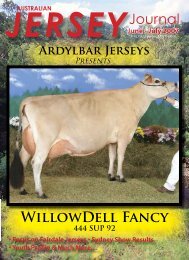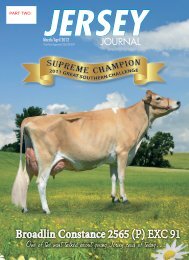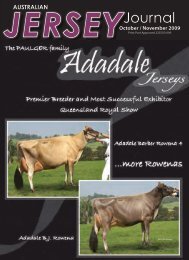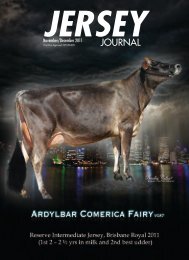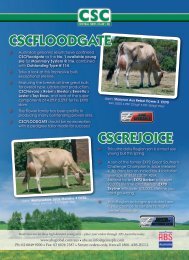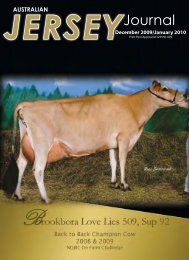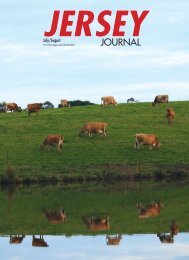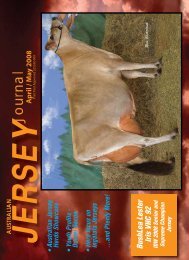Oct/Nov 2010 - Australian Jersey Breeders Society
Oct/Nov 2010 - Australian Jersey Breeders Society
Oct/Nov 2010 - Australian Jersey Breeders Society
You also want an ePaper? Increase the reach of your titles
YUMPU automatically turns print PDFs into web optimized ePapers that Google loves.
He’s also kept busy with his kids, both of whom are<br />
involved in local sporting groups.<br />
The teenagers have kept the Braelyn prefix going<br />
with a strong link to the Silvermine family and also the<br />
Hazels.“They showed last year for the first time and won<br />
a few ribbons.”<br />
Wayne shows at Dorrigo and Bellingen, usually<br />
winning a few ribbons. More competitive is the annual<br />
on-farm challenge in <strong>Nov</strong>ember that he co-ordinates for<br />
the Beautizone jersey cattle club, covering an area of<br />
mid-north coast NSW and usually attracting 100-120<br />
entries.<br />
The slog paid off, the very fit and wiry Wayne bought<br />
40ha next to his dad’s place. It is an undulating-to-steep<br />
slice of very rich, basaltic soil boasting an average<br />
annual rainfall of 2000mm.<br />
He came to the property after his Dad retired from<br />
dairying in 1992. When his Dad died two years ago,<br />
his 80ha property was halved between Wayne and<br />
his brother Murray, a beef farmer. Wayne built the<br />
dairy, a 10aside herringbone … an improvement from<br />
the original six-cow walk-in. Today he milks through a<br />
basic one-person operation with no techno-wizardry.<br />
“Just plain and simple,” said Wayne. ‘We’re not greatly<br />
ambitious people. I don’t want to milk 300 animals.”<br />
He is running 115 milkers year round. “I tend to have a<br />
few calve in the autumn and the spring, about 70% of<br />
calvings occur in those two seasons. With dries, heifers<br />
and calves, his herd totals 200 and last year retained<br />
about 50 heifers.<br />
Pasture silage of 160 big round bales is cut off the home<br />
farm. That, along with 5kg/cow/day of supplement plus<br />
ad lib grass sees his girls clocking up a rolling herd<br />
average of 5866 litres at 215kg protein and 260kg fat.<br />
Out in the paddocks, “everything else goes in the cows’<br />
mouths,” said Wayne.<br />
The place is sown down in autumn to ryegrass, clovers<br />
and plantain. The herb is a good crop in the autumn, he<br />
said, and one that the cows seem to like. Other plantings<br />
include chicory and some brassica. Running alongside<br />
Wayne’s operation is his dad’s former stud, now the<br />
interest of his kids Garth and Catherine, aged 15 and<br />
13. (“Yes, and I’m 57 … quite old” he laughed.)<br />
His links with the area are deep. He is vice-president<br />
of the local show society treasurer of showground trust<br />
and strong connections with local historical society.<br />
Over the past 10 years he had trod the boards with the<br />
local drama club and, having a bit of a literary bent, he<br />
writes bush poetry.<br />
The basis of the Moonpah family herd was a bull,<br />
Banyule Quoit from near Heidelberg in Victoria, a stud<br />
established in 1945. Strong families in the Moonpah<br />
herd are Belindas, Models and Handsomes.Show<br />
winners have included Moonpah Clinton Delight and<br />
Moonpah Sambo Darlene, which won champion onfarm<br />
challenge for two consecutive years.<br />
The herd has included a lot of its own cows with the<br />
inclusion of Katandra Hazels and aIngalala Clinton bull<br />
sired by Lester, that is currently in use. “All our visitors<br />
are very impressed to see these Clinton daughters<br />
so uniform, with their udders so well-attached,” said<br />
Wayne. “I like a nice, good type of animal that’s going to<br />
produce well. She needs a good udder because that’s<br />
the main part of the cow and that’s what’s going to earn<br />
you money.”<br />
Overall, he considers that the modern jersey is “a good<br />
cow, she’s strong, But it’s up to breeders now to do their<br />
homework. You need to breed individually. You need<br />
to look at each animal.” A trend that Wayne is noticing<br />
is the demand from lifestyle farmers for a house cow.<br />
Located only 60km from Coffs Harbour means Wayne is<br />
in striking range of sea-changers keen to hand-milk.<br />
“I get heaps of calls these days,” he said. “People are<br />
funny. A lot of them are hobby farmers who’ve never<br />
milked a cow before. You’ve got to do a bit of spade work<br />
with them some of them … they have no idea.” In the<br />
past year he estimates he has sold “about half a dozen<br />
cows and as many heifers… and it’s rising.”<br />
He halter trains all his cows as calves and has a herd<br />
that is exceptionally quiet.<br />
He also speaks to them. And they answer back. Don’t<br />
believe it? OK… just listen.<br />
“Last year was an exceptional year,” said Wayne. “We<br />
had four major rain events and got 120 inches before<br />
June and then it never rained until <strong>Nov</strong>ember. It was a<br />
highly unusual season. The cows were sick of the rain<br />
and they kept saying ‘can you get us out of this mud?’”<br />
See? Talking cows!<br />
18 — <strong>Jersey</strong>Journal<strong>Oct</strong>ober/<strong>Nov</strong>ember <strong>2010</strong>




